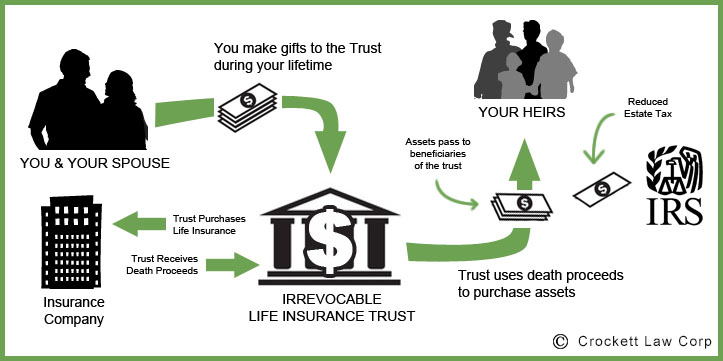A permanent estate builder that provides asset protection and covers future generations

What does a Life Insurance trust do?
Life Insurance Trusts – A Life Insurance Trust is a permanent, irrevocable trust that is established to own one or more life insurance policies that cannot be altered, amended, or revoked. When the insured named in the life insurance policy dies, the life insurance company pays the policy proceeds to the Life Insurance Trust, instead of to the estate of the insured. The Trustee of the Life Insurance Policy then distributes the proceeds to the beneficiaries of the Life Insurance Trust according to the instructions in the Declaration of Trust.

Benefits of a Life Insurance Trust
- Save estate taxes – A Life Insurance Trust (LIT) can be set up to keep the death benefit proceeds out of the insured’s estate and thus avoid estate taxes that would have to be paid if the proceeds were just to be paid directly to the insured’s estate.
- Proceeds distribution control – A Life Insurance Trust (LIT) sets up a mechanism to control the distribution of life insurance proceeds. For example, instead of just having a $500,000 policy being paid to children who have not reached maturity, the LIT can provide that the money be held and paid out to the children in installments over a period of time.
- Protection from creditors – The LIT can be set up to prevent creditors of the Trust beneficiaries from attaching or obtaining their share of the death benefit proceeds. This would be known as a “spendthrift trust” provision which could be written into the LIT. Also, none of the creditors of the insured can reach the assets of the LIT.
- Permanent guarantee of money to your heirs – Since the LIT is not owned by the insured, and since it is permanent, the death benefit payment will go to the insured’s heirs as the trust beneficiaries, free of tax and free of any debts or creditors claims against the estate of the insured. The concept is that the insured puts money in trust now and since the gift to the FIT is permanent, it legally remains there and the insurance policy legally remains there until the policy pays off. The only serious risk is if money is not put in to pay the premiums then the insurance could lapse.
How is a Life Insurance Trust Established?
A LIT is established by having an attorney prepare a Declaration of Trust. The Declaration of Trust states in precise detail exactly how the trust is to be run, who will receive money from the Trust, and when the money will be distributed. Once the Declaration of Trust is signed, the trust is given money to pay for life insurance and then the Trust buys the life insurance policy and owns the policy in the name of the Trust.
Terminology of Life Insurance
Life insurance is a legal contract called an insurance policy entered into between the policy owner and a life insurance company. The policy requires the owner to pay premiums to the company, usually over a period of years on a monthly, quarterly, or annual basis. In return the company promises to the policy owner that it will pay a sum of money to the policy beneficiary upon the death of the insured.
Life insurance proceeds that to to a Life insurance trust are NOT subject to the federal estate tax. If the insurance policy is owned by the insured, or if the insured is the beneficiary of the policy, then the policy proceeds are counted as part of the insured’s taxable estate on the insured’s death and will be subject to federal estate tax. On the other hand, if the same life insurance policy is owned by an LIT that benefits the insured’s children, the children will receive the $1,000,000 life insurance proceeds free of the estate tax and free of any income tax. This tax savings can work also if the insured’s children own the policy outright.
One key factor to save the estate tax is that the insured must not be the owner of the policy. Either way, unless the trust is properly established and maintained, and unless the payment of the premiums are handled in the proper way, the tax savings can be lost and the life insurance proceeds will be drawn back into the insured’s taxable estate
Another key factor is the three year rule
If a policy owned by the insured is transferred into a LIT in year one and the insured dies in year two then the death benefit proceeds are included in his taxable estate for estate tax purposes. Also, if the insured retains or had the right to change the beneficiary on the policy, or if the insured retains the right to change the beneficiaries of the LIT within three years of his death, then the death benefit proceeds are included in his taxable estate.
Choosing a Trustee
The insured cannot serve as the trustee nor can a beneficiary or the creator of the LIT. Also, nobody who is related to the insured or who is employed by the insured or any company he controls can serve as the trustee. The trustee must be “independent” as defined by the tax laws which means a bank or independent trust company or professional or unrelated person. The only power the insured may retain over the trust is the right to remove one independent trustee and appoint another.Community Property complications. Since California is a community property state, only separate property can be used to fund the insurance premium payments when a spouse is a beneficiary of the LIT. Otherwise, half of the insurance proceeds get dragged back into the insured’s estate. The solution is to have a proper written agreement to convert community property into separate property and then put the premium money into a separate property bank account prior to contributing it to the LIT for the premium payment which is made by the LIT.
Possible annual gift tax exclusion “Crummy Rule”
Transfers to a LIT to fund the insurance premiums have gift tax issues. The best way to structure the LIT is to be able to claim the gift is a present interest and hence qualifies for the annual $14,000 gift tax exclusion. That way, the transfers to the trust don’t count against the lifetime exclusion from estate and gift taxes. As a result of the Crummy tax case, if the beneficiaries are given proper written notice each time the premium money is put into the LIT and if that notice gives the beneficiaries the right for at least 30 days to pull the money out, the transfer will qualify for a gift tax exclusion.
Are life insurance premiums tax deductible?
Generally they are not.
Cautions
The information in this memo is for general informative purposes and may not fit every situation. You are cautioned to have any LIT situation thoroughly reviewed and appropriate documentation prepared by legal counsel before you actually commit to it. Also, it must be properly administrated and there must be files and documentation to be able to prove proper administration.
Conveniently located in Newport Beach near the John Wayne Airport
We are located near the Orange County California John Wayne Airport. My office is catty-corner from Fletcher-Jones Motorcars; —right behind the rear entrance of Newport Lexus on Dove Street. Here is a picture of my office building and a Google Map to get your bearings.
 Orange County Estate Planning Lawyer Blog
Orange County Estate Planning Lawyer Blog


